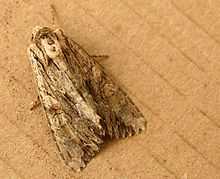Dark Arches
| Dark Arches | |
|---|---|
 | |
| Scientific classification | |
| Kingdom: | Animalia |
| Phylum: | Arthropoda |
| Class: | Insecta |
| Order: | Lepidoptera |
| Family: | Noctuidae |
| Tribe: | Apameini |
| Genus: | Apamea |
| Species: | A. monoglypha |
| Binomial name | |
| Apamea monoglypha (Hufnagel, 1766) | |
| Synonyms | |
| |
.jpg)
.JPG)
The Dark Arches (Apamea monoglypha) is a moth of the family Noctuidae. It is a common, sometimes abundant, European species. It is found in most of Europe except northernmost Fennoscandia and the southern parts of the Iberian Peninsula and Greece. The species is also found in Anatolia, Western Asia and central Asia. In the Alps it is found up to heights of 2,500 meters. The smaller subspecies sardoa is found on Sardinia and Corsica.
This species has a wingspan of 46 to 54 mm, the forewings varying from pale greyish brown to almost black and cryptically patterned. All but the darkest individuals usually have an obvious black mark close to the dorsum and a pale "zig-zag" subterminal line. The hindwings are whitish with darker venation and a dark shaded band at the margin. The larva is pale with a black head and black spots.
This moth flies at night. In the British Isles it is active from June to August with a second brood sometimes emerging in September and October. It is attracted to light, sugar and many nectar-rich flowers.
The larva feeds on various grasses including tussock grasses, orchard grass, ryegrass, reed grasses, and fescues such as sheep's fescue.[1] This species overwinters as a larva.
Notes
References
- Chinery, M. Collins Guide to the Insects of Britain and Western Europe. 1986 (Reprinted 1991).
- Skinner, B. Colour Identification Guide to the Moths of the British Isles. 1984.
| Wikimedia Commons has media related to Apamea monoglypha. |
External links
- Lepiforum
- Funet Taxonomy
- Fauna Europaea